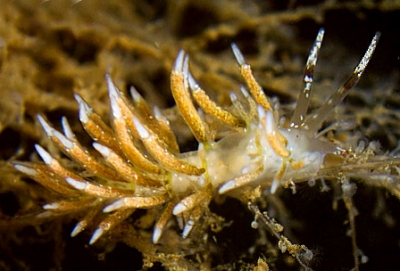
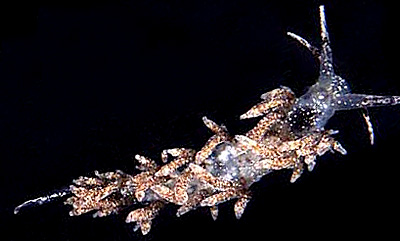
Cuthona amoena
(Alder & Hancock, 1845)
Order: NUDIBRANCHIA
Suborder: AEOLIDINA
Family: Tergipedidae
DISTRIBUTION
Atlantic coast of Europe [Mediterranean, British Isles, Holland].
PHOTO
Upper: South Gortein, Loch Fyne, 15 m, Scotland, Atlantic Ocean, 30 April 2006, Rocky reef. Length: 15 mm. Photographer: Jim Anderson. Lower:The Netherlands. Photo: Peter H. van Bragt
Like many species of the genus, Cuthona amoena is a small and rather cryptic species. It aparently feeds exclusively on the hydroid Halecium halecinum on which it is usually found. It is translucent, if not transparent, with the viscera and brownish digestive gland showing through the body wall. The back of the body and the cerata are covered in scattered gold or yellowish-white pigment specks, more abundant in some animals than others. The specks are particularly concentrated at the tips of the head tentacles and cerata. There is a brown band about midway down each rhinophore, and around each oral tentacle and often there is brown pigmentation at the base of the cerata. It reaches a maximum of about 12 mm in length.
Another species, Cuthona rubescens, feeds on the same common hydroid and looks very similar in colour and shape. The most distinctive external difference is that it does not have a brown band in the middle of the oral tentacles.
- Picton, B. E. and Morrow, C. C. (1994) A Field Guide to the Nudibranchs of the British Isles. London, Immel Publishing Ltd. 143pp.
-
Thompson, T.E. & Brown, G.H. 1984. Biology of Opisthobranch Molluscs, Volume II.
Rudman, W.B., 2006 (May 8) Cuthona amoena (Alder & Hancock, 1845). [In] Sea Slug Forum. Australian Museum, Sydney. Available from http://www.seaslugforum.net/find/cuthamoe
Related messages
Re: Facelina dubia from Turkey
November 18, 2008
From: Greg Brown
Concerning message #22029:
Hi Bill,
I question the identification of Facelina dubia from Turkey which would have a wide body and distinct propodial tentacles not seen in the photos. I suggest a Cuthona species and the appearance is reminiscent of Cuthona amoena as found around the UK, especially with the brownish bands midway up the rhinophores. C. amoena is known from the western Mediterranean but I don't know about any Turkish records.
Best regards,
Greg Brown
sally.andgreg7@ntlworld.com
Brown, G.H., 2008 (Nov 18) Re: Facelina dubia from Turkey. [Message in] Sea Slug Forum. Australian Museum, Sydney. Available from http://www.seaslugforum.net/find/22045Dear Greg,
Thanks for alerting me to this fairly fundamental error. Propodial tentacles are usually the first thing I look for in aeolid photos. The ceratal arrangement in the lower photo puzzled me but I assumed the animal had lost a lot of cerata. I should have referred this to Bernard Picton but for some reason that escapes me, I felt ok with Facelina dubia. I agree that Cuthona is a much more sensible suggestion.
Best wishes,
Bill Rudman
Facelina dubia from Turkey
November 10, 2008
From: Tunca Rodoplu
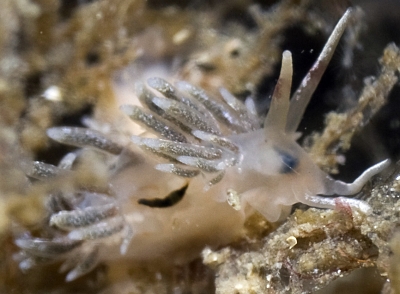
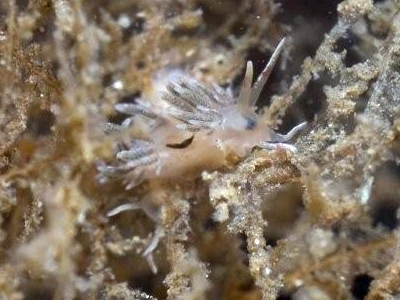
Hi Bill,
We have spotted the attached animals while diving in Neandros Island in Marmara Sea very close to Istanbul. We really couldn't identify the animals but they look like Facelina dubia. Is our identification correct.
Locality: Neandros Island - Marmara Sea, 25 m, Turkey. 1 cm long. Photographer: Göker Göksel.
Regards,
Tunca Rodoplu
tunca.r@karfo-karacasulu.com
Rodoplu, T., 2008 (Nov 10) Facelina dubia from Turkey. [Message in] Sea Slug Forum. Australian Museum, Sydney. Available from http://www.seaslugforum.net/find/22029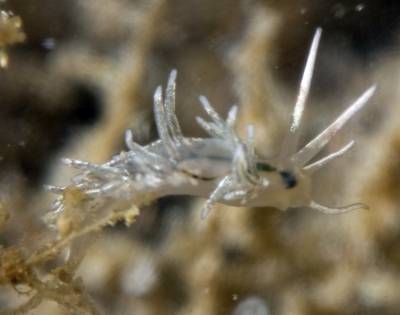
Note added 18 Nov 2008: This is almost certainly Cuthona amoena - see message #22045.
Dear Tunca,
These animals certainly fit Facelina dubia, with smooth rhinophores and white speckled markings. The dark green crescent shaped mark on the right side of the body - in the upper two photos, is the intestine full of faecal material. I am not sure if the animal in the lower photo is the same as n the upper photos, but you can see there that the intestine is almost empty.
Best wishes,
Bill Rudman
Cuthona amoena from Scotland
May 9, 2006
From: Jim Anderson

Dear Bill,
This animal was found on the hydroids growing on the disused electricity cable that drapes over the reef at 15 m at the site. ID by Dr. Bernard Picton.
Locality: South Gortein, Loch Fyne, 15 m, Scotland, Atlantic Ocean, 30 April 2006, Rocky reef. Length: 15 mm. Photographer: Jim Anderson.
Regards,
Jim A
http://www.scottishnudibranchs.co.uk/
jander4454@gmail.com
Anderson, J., 2006 (May 9) Cuthona amoena from Scotland. [Message in] Sea Slug Forum. Australian Museum, Sydney. Available from http://www.seaslugforum.net/find/16529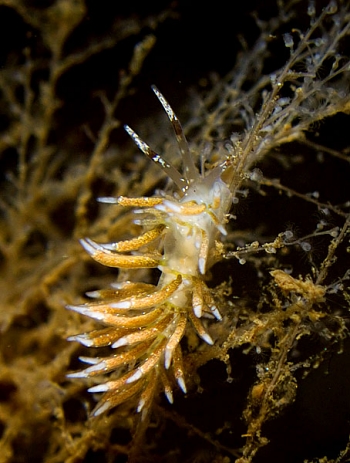
Thanks Jim,
Your photo has reminded me that the Fact Sheet for this species was blank!
I am glad you got an identification from Bernard Picton because there are a number of very similar looking species in your part of the world. One in particular, C. rubescens, feeds on the same hydroid as C. amoena - Halecium halecinum - and the one sure external feature which apparently distinguishes the two is that C. amoena has a brown band on the oral tentacles, about midway down their length. Both species have a similar brown band on the rhinophores. And as luck would have it, the only things I can't see in your excellent photo are the oral tentacles.
Best wishes,
Bill Rudman
Cuthona amoena from the Netherlands
October 4, 2002
From: Peter H. van Bragt

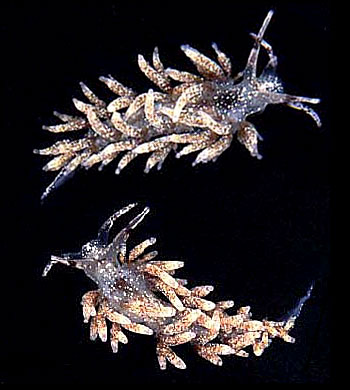
Hello Bill,
Just another Dutch species to add to your virtual collection.
Cuthona amoena is a small and rather cryptic species which can commonly be found on Halecium halecium on the Dutch coast. However few divers find it as it is a small species (max. 12mm.), its colour matches perfectly that of the hydroid and almost always it hides between the branches at the base of the hydroid. Until 1984 it was only found twice in the Netherlands but at present it is very common during the late spring and summer months.
With Dutch greetings
Peter H. van Bragt
vanbragt.phjm@hsbrabant.nl
Bragt P. H., 2002 (Oct 4) Cuthona amoena from the Netherlands. [Message in] Sea Slug Forum. Australian Museum, Sydney. Available from http://www.seaslugforum.net/find/8015Thanks Peter,
Bill Rudman
